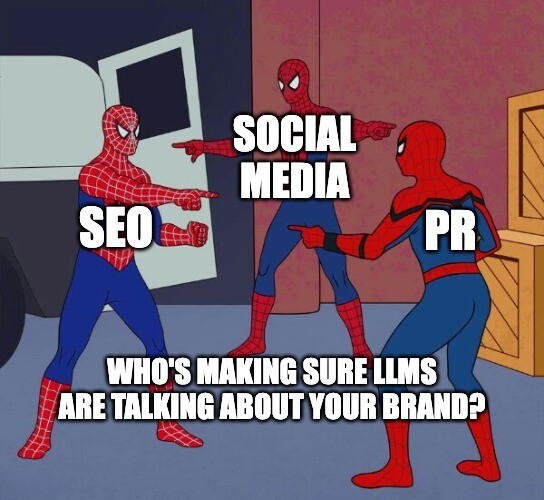What's inside
People are skipping search engines and going straight to LLMs like ChatGPT or Perplexity to ask questions and discover new products. Is your marketing budget ready for that?
Think back to the last time your CEO got quoted in an industry outlet. That line wasn’t just good PR; it’s now part of the training data machines use to understand your brand.
While your paid social campaign ends when the budget does, a quote in a respected outlet can influence AI-powered searches for years, especially if it’s optimized for LLMs to find. This isn’t some futuristic strategy. It’s already happening.
If you want your brand to show up in LLMs, your teams need to work differently, both strategically and tactically.

How should marketing teams change their day-to-day operations?
For the last decade, digital marketing teams have been split between performance (SEO, analytics, UX, conversion) and brand (social, PR). That split no longer makes sense. LLMs don’t judge your content like a person or a traditional search engine.
Every member of the marketing team should be working toward the same goals. The old lines between marketing roles have been erased by AI.
1. To get LLMs to take notice, you need to build authority in your category.
What topics do you need to own in AI-generated answers? What questions should instantly point to your brand, whether they’re typed in ChatGPT, Perplexity, or your own website search? Once you have a list of your key topics, move to the next step.
2. Create shared “key topics” goals.
Say you’re an insurance company that wants to lead on group health plans. Your PR team works on getting you quoted in articles on freelancer benefits, while your social team works with influencers talking about the gig economy. The idea is for everyone to work in sync building authority on your key topics, each from a different angle. Assign clear tasks to each team to make progress—this is the time to join forces.
3. Appoint someone to own AI visibility.
Not to “run the channel”; but to coordinate every effort that shapes how your brand shows up in AI-generated responses. Maybe this project manager comes from within your SEO team, because they’re starting with the most knowledge of how LLMs work.
4. Share reporting across teams.
There needs to be a regular reporting cadence, where each team feeds back to the group: PR shares earned media, expert quotes, and placement data. SEO tracks how and where your brand appears in LLMs. UX shares behavioral insights to help shape priorities.
AI is rewriting the rules of online discovery. It’s the biggest shift since the launch of Google. The fastest brands to adapt will be the ones already tearing down the wall between brand and performance, and building real strategies for LLMs. The sooner we get it, the sooner we show up where it counts: in the answers.
At AI Findr, we’re already working on this; across industries like banking, insurance, retail, education, and shopping centers. Want to hear how others are tackling it, or share your own experience? You know where to find us.




